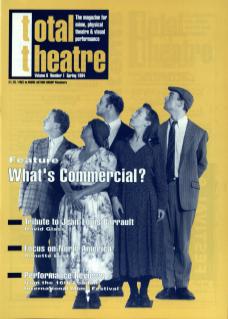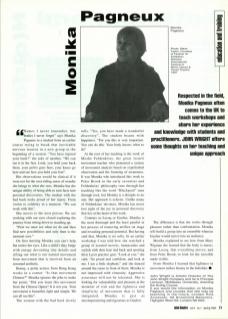‘Names I never remember, but bodies I never forget,’ says Monika Pagneux to a student from an earlier course trying to break that inevitable nervous tension in a new group at the beginning of a session. ‘You have injured your back?’ She asks of another. ‘We can see it in the feet. Look, you hold your back there, your pelvis goes here, your knees go here and see how you hold your feet.’
Her observations would be clinical if it were not for the overriding sense of wonder she brings to what she sees. Monika has the unique ability of being able to turn facts into personal discoveries. The student with the bad back looks proud of her injury. From victim to celebrity in a moment. ‘We can work with this.’
She moves to the next person. We are working with our eyes closed exploring the journey from sitting down to standing up.
‘First we must see what we do and then find new possibilities and only then is the moment ours.’
On first meeting Monika you can't help but notice her eyes. Like a child's they bulge with energy, devouring tiny details and sifting out what is our natural movement from movement that is received from an assumed aesthetic.
Bonny, a petite actress from Hong Kong works in a corner. ‘Is that movement Chinese?’ Monika ignores the joke to make her point: ‘Did you learn this movement from the Chinese Opera? It is not you. Your movement is beautiful, light and simple. We can all see this.’
The woman with the bad back slowly rolls. ‘Yes, you have made a wonderful discovery.’ The student beams with happiness. ‘For you this is very important. You can do this. Your body knows what to do.’
At the root of her teaching is the work of Moshe Feldenkrais, the great Israeli movement teacher who pioneered a system of movement analysis based on experiential observation and the fostering of awareness. It was Monika who introduced this work to Peter Brook in the early seventies and Feldenkrais' philosophy runs through her teaching like the word ‘Blackpool’ runs through rock, but Monika is a disciple to no one. Her approach is eclectic. Unlike many of Feldenkrais' devotees, Monika has never lost sight of the joy in personal discovery that lies at the heart of the work.
Contrary to Lecoq or Gaulier, Monika is the most thorough and the least painful in her process of removing artifice on stage and revealing personal potential. But having said that, Monika is no softy. In an earlier workshop I was told how she watched a group of assured movers, immaculate and stylish with their hair tied back and sporting their Lycra practice gear. ‘Look at you,’ she said. ‘So proud and confident, and look at me. I am a little elephant.’ And she danced around the room in front of them. Monika is not impressed with virtuosity. Aggressive assurance will not be tolerated. She is looking for vulnerability and pleasure at the moment of risk and the lightness and simplicity of movement that is fully integrated. Monika is just as uncompromising and rigorous as Gaulier.
The difference is that she works through pleasure rather than confrontation. Monika will build a group into an ensemble whereas Gaulier would turn it into an audience.
Monika explained to me how from Mary Wigman she learned that the body is music; from Lecoq, that everything moves; and from Peter Brook, to look for the invisible made visible.
From Monika I learned that lightness in movement strikes beauty in the beholder.
John Wright is Artistic Director of The John Wright Company and he is Principal Lecturer, Middlesex University, directing the Acting Course.

